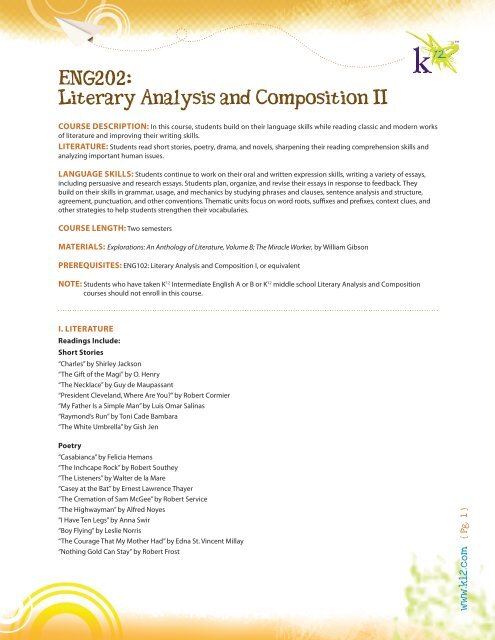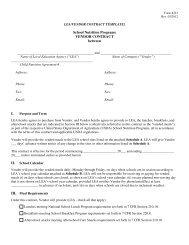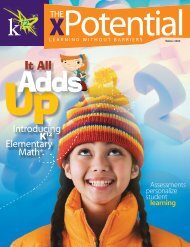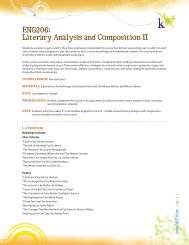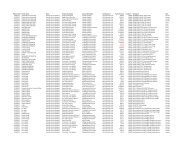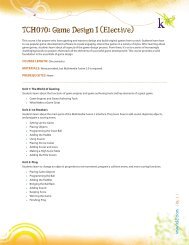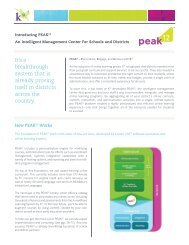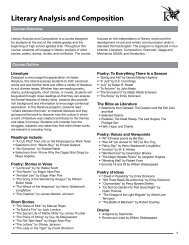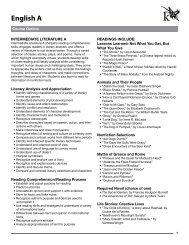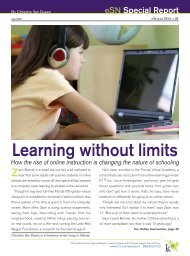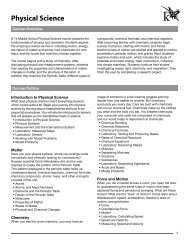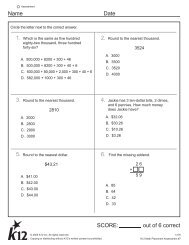ENG202: Literary Analysis and Composition II - K12.com
ENG202: Literary Analysis and Composition II - K12.com
ENG202: Literary Analysis and Composition II - K12.com
You also want an ePaper? Increase the reach of your titles
YUMPU automatically turns print PDFs into web optimized ePapers that Google loves.
<strong>ENG202</strong>:<strong>Literary</strong> <strong>Analysis</strong> <strong>and</strong> <strong>Composition</strong> <strong>II</strong>Course Description: In this course, students build on their language skills while reading classic <strong>and</strong> modern worksof literature <strong>and</strong> improving their writing skills.Literature: Students read short stories, poetry, drama, <strong>and</strong> novels, sharpening their reading comprehension skills <strong>and</strong>analyzing important human issues.Language Skills: Students continue to work on their oral <strong>and</strong> written expression skills, writing a variety of essays,including persuasive <strong>and</strong> research essays. Students plan, organize, <strong>and</strong> revise their essays in response to feedback. Theybuild on their skills in grammar, usage, <strong>and</strong> mechanics by studying phrases <strong>and</strong> clauses, sentence analysis <strong>and</strong> structure,agreement, punctuation, <strong>and</strong> other conventions. Thematic units focus on word roots, suffixes <strong>and</strong> prefixes, context clues, <strong>and</strong>other strategies to help students strengthen their vocabularies.Course length: Two semestersMaterials: Explorations: An Anthology of Literature, Volume B; The Miracle Worker, by William GibsonPrerequisites: ENG102: <strong>Literary</strong> <strong>Analysis</strong> <strong>and</strong> <strong>Composition</strong> I, or equivalentNote: Students who have taken K 12 Intermediate English A or B or K 12 middle school <strong>Literary</strong> <strong>Analysis</strong> <strong>and</strong> <strong>Composition</strong>courses should not enroll in this course.I. LITERATUREReadings Include:Short Stories“Charles” by Shirley Jackson“The Gift of the Magi” by O. Henry“The Necklace” by Guy de Maupassant“President Clevel<strong>and</strong>, Where Are You?” by Robert Cormier“My Father Is a Simple Man” by Luis Omar Salinas“Raymond’s Run” by Toni Cade Bambara“The White Umbrella” by Gish JenPoetry“Casabianca” by Felicia Hemans“The Inchcape Rock” by Robert Southey“The Listeners” by Walter de la Mare“Casey at the Bat” by Ernest Lawrence Thayer“The Cremation of Sam McGee” by Robert Service“The Highwayman” by Alfred Noyes“I Have Ten Legs” by Anna Swir“Boy Flying” by Leslie Norris“The Courage That My Mother Had” by Edna St. Vincent Millay“Nothing Gold Can Stay” by Robert Frostwww.k12.com { Pg. 1 }
“A Poison Tree” by William Blake“Beauty” by E-Yeh-Shure’“Barter” by Sara Teasdale“All the world’s a stage” (from As You Like It) by William Shakespeare“The Wind Began to Rock the Grass” by Emily Dickinson“I’ll Tell You How the Sun Rose” by Emily Dickinson“There Is No Frigate Like a Book” by Emily Dickinson“Harlem [2]” by Langston Hughes“Hold Fast Your Dreams” by Louise DriscollDramaThe Miracle Worker by William GibsonNovels (choose two of the following)Jesse by Gary SotoFahrenheit 451 by Ray BradburyLet the Circle Be Unbroken by Mildred TaylorThe Pearl by John SteinbeckPartial List of Skills Taught:• Describe characters based on speech, actions, or interactions with others.• Demonstrate knowledge of authors, characters, <strong>and</strong> events of works of literature.• Identify, analyze, interpret, <strong>and</strong> discuss the following elements of literature:– character traits <strong>and</strong> motivations– allusions– conflict <strong>and</strong> resolution– irony– figurative language, imagery, <strong>and</strong> sensory language– point of view– author’s attitude or tone– elements of plot• Identify, analyze, <strong>and</strong> discuss elements of a drama.• Identify analyze, <strong>and</strong> discuss elements of a short story.• Identify, analyze, <strong>and</strong> discuss theme in literary works.• Identify cause-<strong>and</strong>-effect relationships.• Make inferences <strong>and</strong> draw conclusions.• Recognize the effect of setting or culture on a literary work.• Recognize use of language to convey mood.• Discuss author’s purpose <strong>and</strong> analyze literary devices used to accomplish it,including language, organization, <strong>and</strong> structure.• Compare <strong>and</strong> contrast literary characters <strong>and</strong> selections.www.k12.com { Pg. 2 }
<strong>II</strong>. <strong>Composition</strong>Autobiographical Incident• What Is an Autobiographical Incident?• Plan an Autobiographical Incident• Organize an Autobiographical Incident• Write an Autobiographical Incident• Revise an Autobiographical Incident• Proofread <strong>and</strong> Publish an Autobiographical IncidentLetter to the Editor• What Is a Letter to the Editor?• Choose a Topic• Gather Information• Plan a Letter to the Editor• Logical Thinking• Write a Letter to the Editor• Revise a Letter to the Editor• Proofread <strong>and</strong> Publish a Letter to the EditorPersuasive Speech• What Is a Persuasive Speech?• Repurpose a Letter/Essay• Practice a Persuasive Speech• Deliver <strong>and</strong> Listen to a Persuasive SpeechWriting to a Prompt• What Is a Narrative Prompt?• Use a Narrative Rubric• What Is a Persuasive Prompt?• Use a Persuasive Rubric• Write to a Prompt<strong>Literary</strong> Essay about Character• What Is a <strong>Literary</strong> Essay about Character?• Choose <strong>and</strong> Develop a Topic• Plan <strong>and</strong> Organize a <strong>Literary</strong> Essay• Focus on Unity <strong>and</strong> Coherence• Write a <strong>Literary</strong> Essay• Revise a <strong>Literary</strong> Essay• Proofread <strong>and</strong> Publish a <strong>Literary</strong> Essaywww.k12.com { Pg. 3 }
Research Paper• What Is a Research Paper?• Focus on a Topic• Find Information Sources• Take Notes• Cite Sources• Organize <strong>and</strong> Outline a Research Paper• Write a Research Paper• Focus on Citations• Revise a Research Paper• Proofread <strong>and</strong> Publish a Research PaperPractical Writing• Analyze Examples of Practical Writing• Plan a Cover Letter <strong>and</strong> Application• Use Appropriate Language in Business Correspondence• Write a Cover Letter <strong>and</strong> Complete an Application• Hints for Revising• Revise a Cover Letter <strong>and</strong> Application• Proofread <strong>and</strong> Publish a Cover Letter <strong>and</strong> Application<strong>II</strong>I. GRAMMARIntegrated lessons on selected topics in grammar, usage, <strong>and</strong> mechanics include:• Sentences• Compound Subjects <strong>and</strong> Compound Verbs• Natural <strong>and</strong> Inverted Sentence Order• Sentence Errors• Direct <strong>and</strong> Indirect Objects• Subject Complements• Prepositional Phrases• Appositives <strong>and</strong> Appositive Phrases• Commas• Independent <strong>and</strong> Dependent Clauses• Adjective Clauses• Adverb Clauses• Sentence Structure• Italics <strong>and</strong> Quotation Marks for Titles• Writing Quotations• Apostrophes for Possession• Principal Parts of Regular Verbs• Principal Parts of Irregular Verbs• Verb Tensewww.k12.com { Pg. 4 }
• Progressive Forms• Active <strong>and</strong> passive voice• Agreement• Negative words• Capitalization• Nominative, objective, <strong>and</strong> possessive case pronouns• Agreement of pronouns <strong>and</strong> antecedents• Indefinite pronouns• Participles• Gerunds• Infinitives• Misplaced modifiers• Colons <strong>and</strong> semicolonsCopyright © 2010 K12 Inc. All rights reserved. K12® is a registered trademark <strong>and</strong> the K¹² logo, xPotential <strong>and</strong> Unleash the xPotential are trademarks of K12 Inc.www.k12.com { Pg. 5 }


